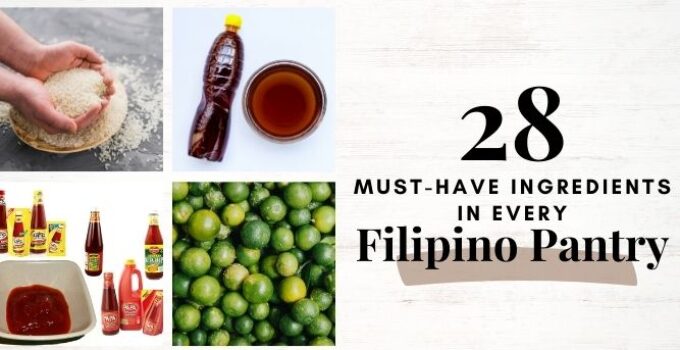New to Filipino cooking? No worries, because we’ve got an easy-to-follow shopping list that will give you a head start! With these basic Filipino pantry items, you can already cook a good range of Filipino dishes efficiently.
Compared to other cuisines, Filipino pantry essentials are quite simple and you are probably familiar with most of the items here. This list comes as a guide to help you understand the ingredients better, learn their substitutions, and know where to find them. Happy shopping!
This list comes in four categories: (1) rice/noodles, (2) condiments, (3) dry goods, (4) fresh goods. Most of the items here can be stored for a long period of time so you don’t have to buy them frequently.
To easily navigate the list, refer to the table of contents below:
Rice/Noodles
1. White Rice
White rice or kanin is a staple in Filipino dining. Most local meat and vegetable dishes are accompanied with freshly cooked white rice.
Since it is widely consumed, rice is abundant and can be sourced in almost all markets, supermarkets, and grocery stores. There are also quite a number of varieties, they differ in grain length, texture, and fragrance. Popular varieties you’ll find are Jasmine, Sinandomeng, and Dinorado.
Aside from white rice, there are also less refined types of rice that provide more fiber content like brown rice, red rice, purple rice, and black rice.
2. Glutinous/ Malagkit Rice
Glutinous or sticky rice, also known as malagkit, is a type of rice that appears to be translucent and has a relatively high amount of starch. This makes it sticky when cooked. This rice is used in several Filipino porridge dishes and delicacies.
Glutinous rice is usually sold alongside white rice or at baking supply stores.
3. Rice Flour
Rice flour is a milled or powdered form of white rice or glutinous rice. In Filipino cooking, it is used as a thickening agent or as the main ingredient of several fine-textured rice cakes.
Rice cake recipes may either call for rice flour or glutinous rice flour, depending on how sticky the rice cake is. Rice flour is usually sold in baking supply stores as well.
4. Dried Pancit
The Philippine cuisine includes several pancit or noodle dishes. Similar to pasta, using dried pancit is a very convenient and time-saving way to cook these types of dishes. While there are several types of noodles that vary per region, the most popular ones are available in most marketplaces.
Some pancit types you’d recognize are Canton, Bihon, Sotanghon, Misua, and Miki. Make sure you have one or two in your pantry.
Condiments
5. Soy Sauce
Soy sauce or toyo is a widely used condiment, especially in Asian cuisines. And there’s a high chance that you already have a bottle of this in your pantry.
Unlike other cuisines, the use of soy sauce in Filipino cooking is quite straightforward. There aren’t a lot of varieties and different brands almost taste the same. They are usually mixed in braised dishes or served as a dipping sauce.
6. Vinegar
Vinegar or suka is the condiment most used in Filipino cooking. It is used as a flavoring, a tenderizer, a preservative, a dipping sauce, to mention a few. Vinegar in the Philippines has several varieties, depending on where it is derived from. The most popular is cane vinegar, derived from sugar cane.
Filipinos also love to spice their vinegars to add more flavors when used as a dipping sauce. Popular spiced vinegars in the country are Sukang Pinakurat, Sukang Sinamak, and Sukang Iloco. You’ll find them as delicacies of the regions or provinces they originated from.
7. Patis/ Fish Sauce
Fish sauce or patis is another unique condiment used in Southeast Asian cuisines. It is a fermented mixture of fish and salt and is known to have a strong smell and taste. It is used to add salty flavors to dishes, dressings, and dipping sauces.
8. Bagoong
Bagoong is another salty fermented condiment widely used in the Philippines. It is either made up of shrimp, krill, or fish. Unlike the fish sauce, it has a thicker form and it has a stronger taste and odor.
While bagoong is already mass produced and available in the marketplace, there are still regional varieties specifically produced in the provinces. These are used for their respective dishes like the bagoong monamon (Ilocos province) and bagoong balayan (Batangas province).
9. Banana Ketchup
Like many other cuisines, Filipinos make use of ketchup or catsup as a condiment. It is commonly used in dressings or as dipping sauce.
However, banana ketchup is more used here than the traditional tomato ketchup. It is said that when ketchup was introduced in the country, Filipinos tried to replicate it using banana as it is more abundant than tomatoes.
10. Tomato Sauce/ Paste
Many Filipino dishes make use of tomato sauce or tomato paste as the base sauce.
It is handy to have this in the house so you could easily cook staple Filipino dishes like menudo, caldereta, afritada, and mechado.
Dry Goods/ Spices
11. All-purpose Flour
It is good to always have a stock of all purpose flour or harina in the pantry for its countless applications. You can rely on it to make your breadings for fried foods and make dough for many Filipino breads.
12. Cornstarch
Cornstarch is a handy ingredient as it is used as a thickening agent in many Filipino dishes. A handful of desserts also makes use of this.
Make sure you have this around as it can also serve as a substitute for flour in case you run out.
13. Bread Crumbs
Bread crumbs mainly used in coatings or breadings of many fried foods. It can also be used as a filler for various meat mixtures.
If you’re into baking your own pandesal, this is a must-have since it serves as the main coating of the bread.
14. Salt
Salt or asin is essential to Filipino cooking and probably any cooking in the world. It is rare to find dishes that wouldn’t call for salt as a seasoning.
There are a variety of salt in the local market, but the most common ones are iodized salt and iodized rock salt. Not all salts are created equal so make sure you taste first before adding it to your food.
15. Black Pepper
Black pepper or paminta is another widely used seasoning in Filipino cooking. In the Philippine market, you’ll notice that there are three forms of black pepper: whole (pamintang buo), crushed, and powdered.
Different recipes call for different forms of black pepper so it is good to have all three in your pantry to avoid the hassle of crushing or powdering.
16. Dried Laurel/ Bay Leaves
Laurel (also called Bay) leaves is a fragrant leaf with a distinctive taste. It is a must have ingredient when you are cooking adobo. Filipino cooking makes use of this in dried form, so you can stock up on these without worrying about its freshness.
17. Star Anise
Star Anise is an Asian spice with a unique flavor and scent. It is used to flavor some Filipino dishes, especially those dishes of Chinese origin.
You can also stock this for a long time.
18. Atsuete
Atsuete or Annatto seeds is a condiment mainly used as a food coloring. It gives off a bright red-orange color making food more appetizing. In case you can’t find this, paprika and saffron are good alternatives.
19. Banana Blossoms
Since there is an abundance of banana plants in the Philippines, its flower called banana blossoms, made its way to different local dishes.
This is also available in dried form and can be stocked for a long period of time.
20. Sugar
Sugar is essential in Filipino cooking. You’ll find that even savory dishes with usually call for sugar in their recipes. Most Filipinos are accustomed to having sweet notes in their food.
You’ll notice that there are 3 main types of sugar sold in the marketplace, white sugar, washed sugar, and brown sugar.
White sugar is the most common, it is refined and granulated and used in most in cooking and baking. Washed sugar is a cheaper alternative to white sugar as it is less refined and has traces of molasses. Brown sugar is known for its distinctive brown color due to the molasses present.
Fresh Goods
21. Garlic
Garlic or bawang is a spice used in a lot of Filipino dishes. In Filipino cooking, there is a saying that you can never add too much garlic.
Locally produced garlic are smaller and tastier but any type of garlic is used.
22. Onion
Like garlic, onion or sibuyas is widely used in Filipino cooking as a sautéing ingredient, a salad ingredient, or as a dish garnish.
Different recipes may either call for red onion or white onion. It is good to have both in the pantry.
23. Ginger
Ginger or luya is used mostly as a sautéing ingredient especially in fish and seafood dishes. Filipinos also brew ginger and serve it as a tea called salabat.
Another type of ginger used in some dishes is yellow ginger or turmeric.
24. Tomato
Aside from tomato paste and sauce, fresh tomatoes or kamatis are also used in Filipino cooking. It is used as a cooking ingredient, in salads, and in dipping sauces.
25. Siling Haba
Filipino cooking makes use of chili or sili as the main ingredient to add spiciness or heat.
One of the locally grown chili is the siling haba, a long green chili that gives off moderate spice level.
26. Siling Labuyo
Another local chili variety is the siling labuyo. These are small red chilis that give off a high spice level.
Siling labuyo is used in many Bicolano dishes like Bicol Express and Laing.
27. Calamansi
Calamansi is a citrus fruit highly abundant in the Philippines. This is mainly used in adding acidity to dishes or dipping sauces. It serves as a good alternative to lemon or lime.
28. Eggs
Eggs or itlog are a pantry staple everywhere. Most Filipinos serve eggs during breakfast. Aside from consuming eggs as itself, it is also used as a cooking and baking ingredient.
Filipinos also love salted egg or itlog na pula. These eggs are soaked in salt solution over a period of time. They are served as a side dish or as a garnish in various dishes.
Want to add something to the list? Do you have brand recommendations? Let us know in the comments below!
You may also want to look at our guide on Filipino kitchen tools and equipment:



